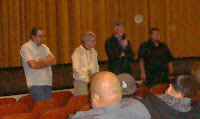Independent Filmmaker/ Producer/Photographer Indigenous Blogger...Learning about California Bird Singing, Preservation and Cultural Documentation www.NativeImagesPG.com www.WeAreBirdsDocumentary.com Contact us at, NativeImagesPG@Gmail.com
Wednesday, March 31, 2010
From San Manuel Mission Indians... “The People of the Pines, The California Native”
KVCR-TV
.... Monday April 5 at 8:00 p.m. in KVCR’s broadcast areas (East Los Angeles – North San Diego County)
Tuesday, March 30, 2010
Southern California Indian Basketweavers Organization
Spring Gathering
May 14 – 16
Hosted by: Santa Rosa Band of Cahuilla Indians
At the Santa Rosa Indian Reservation Tribal Hall
*Limited Housing for Elders. Call for more information*
Light camping, showers and bathrooms available.
Potluck Dinner Friday Night 6:00 PM
Come Join us in a Fun-Filled Weekend of Weaving, Family and Friends ~Bring Your Own Tents, Chairs, and Weaving Materials~
Call Carrie Garcia or Steven Estrada for More Information 951.654.5544 ext.4138 or 951.658.5311
Directions from Hemet: Take Highway 74 up through Mountain Center towards Palm Desert
Approximately 3 miles from the Junction of Highway 371/74 on right side of highway. Follow signs into reservation. From Temecula: Take Highway 79 to Highway 371. Take 371 through Anza. Take Highway 74 towards Palm Desert. Approximately 3 miles from Junction of Highway 74/371 on right side of highway. Follow signs into reservation.
Friday, March 19, 2010
Three men arrested for allegedly looting Chumash burial site
Three men were arrested earlier this month for allegedly stealing Chumash Indian artifacts from a burial ground in a rural area between Camarillo and the Pacific Coast Highway.
John Watson, 37, Frederick Villela, 40, and Noah Erickson, 23, were arrested March 1 around 10 p.m. in an unincorporated area of Ventura County on multiple charges, including grand theft, trespassing on private property and willful injury to archaeological or historical interest.
Deputies made the arrests in connection with a trespassing call they received from a private property near where the men were arrested.
Sgt. Joe Devorick with the Camarillo Police Department said deputies caught the men in possession of various Chumash Indian artifacts.
None of the recovered items were human remains, the detective said.
The Camarillo Acorn will not report the specific location of the arrest as it could lead to additional thefts from the burial site.
Devorick said the original arrest charges against the three men were dropped pending further investigation.
He said, however, that detectives will present a case to the district attorney’s office showing that the three men should be charged with taking items from a Native American historic site and for disturbing a Native American burial ground.
Depending on whether the Ventura County district attorney’s office decides to pursue the charges, the three men could face jail time, Devorick said.
The Chumash, an indigenous people who lived along the Central Coast in small groups, date back roughly 3,000 years. They spoke a common language, hunted, fished and kept a system of trade.
According to Devorick, the three men were interviewed at the Camarillo Police Station, and detectives learned that the men had additional artifacts at their homes.
He said investigators recovered “over 20 items” at the three men’s homes.
The men admitted to taking the items, Devorick said, and were considered “very cooperative” during the investigation.
Devorick said investigators believe the men had been digging in a burial site because of the number of intact relics found in the immediate area.
“(The Chumash) were buried with their possessions,” he said. “So when you find an abundance of whole items, that indicates a burial site.”
The detective said the men were not selling the items, adding that collecting artifacts was “one of their hobbies.”
It is illegal to take artifacts from public land, such as a state or national forest, or from private property without permission of the landowner.
Experts also say that removing artifacts from their natural surroundings makes it nearly impossible for archaeologists to fully understand the significance of the relic.
“It’s like ripping pages out of a book,” said Jan Timbrook, curator of ethnography at the Santa Barbara Natural History Museum. “You completely lose the context.”
Ray Corbett, associate curator of archaeology at the museum, said taking items from an archaeological site is akin to taking a piece from a puzzle. He said when enough pieces are taken “what you’re really looking at becomes very skewed.”
Scientists have a relatively clear idea of the region’s timeline as it relates to humans but “the farther back in time you go, the murkier our understanding,” the archaeologist said.
Corbett said that it’s relatively common for hikers to come across Chumash artifacts in the region’s surrounding foothills and mountainsides. What’s more, he said, is that hikers unknowingly commit a crime and alter a historic site by pocketing a single artifact.
“Any archaeologist would say it’s a real problem, which it is,” he said. “What’s probably most unfortunate is that very few people ever get caught doing it. One out of a hundred people who do it get caught.”
Corbett said that residents who find Native American artifacts in open space should note the location of the artifacts in as much detail as possible and then report the site to a museum or the appropriate forestry department.
Devorick said police are working with the Chumash Indians to return the items to the site.
Thursday, March 11, 2010
Festival of Native Film and Culture 2010

 Here at todays 8pm showing of "Sing Bird"...produced and shot by Sean Owen at the Camelot theaters in Palm Springs, But just before it started... they opened it up with some Bird Singing... Bird Singers from Agua Caliente ...
Here at todays 8pm showing of "Sing Bird"...produced and shot by Sean Owen at the Camelot theaters in Palm Springs, But just before it started... they opened it up with some Bird Singing... Bird Singers from Agua Caliente ...